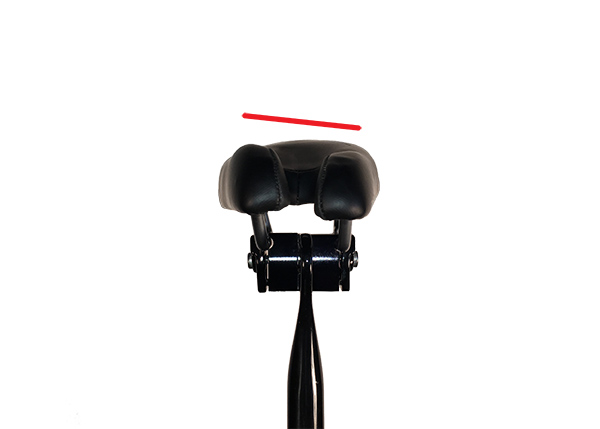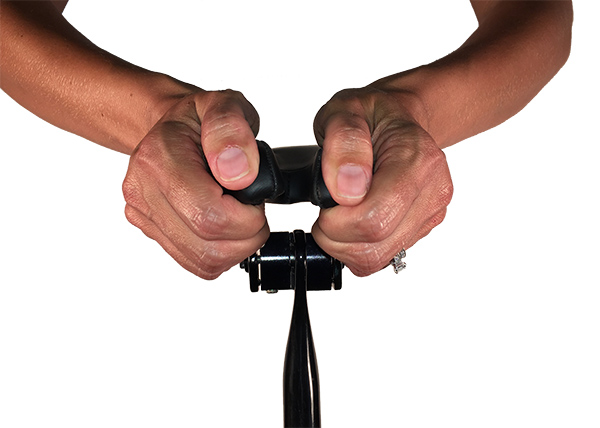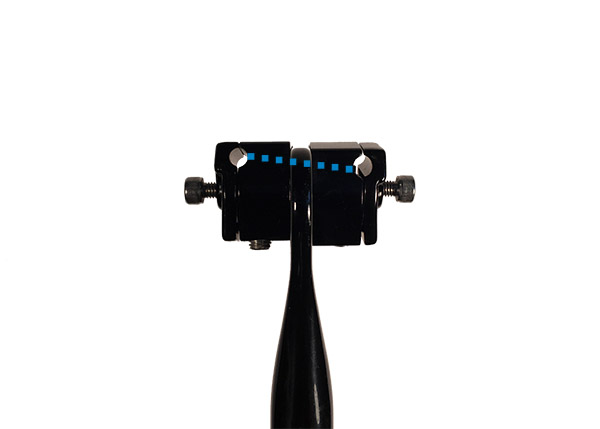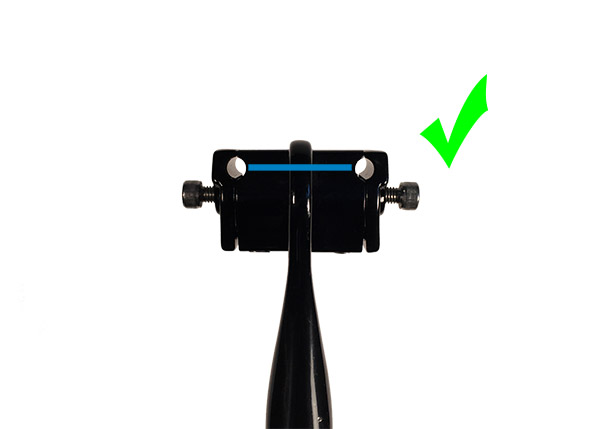- Why ISM?
- Which ISM seat is right for me?
- How do I properly set up my ISM seat?
- I heard that ISM saddles have a wider nose than other brands – is it true?
- Are your seats for road bikes? Triathlon bikes? Hybrid bikes? Mountain bikes?
- Are your seats for men or women?
- My sit bones were measured to be exactly 134.799mm wide. Do you make a seat to match my sit bones?
- Do you offer demo saddles for customers to try?
- I just went for my first ride and I’m sore—why?
- One of the saddle ‘front arms’ appears higher than the other – is that how it’s supposed to be?
- I see you that there are some custom colors and designs offered from time to time. Will you make a seat with my favorite color, picture, or country flag?
- Are your seats UCI compliant?
- What materials are your seat rails made from?
- What type of seatpost should I use?
- What does ISM stand for?
- What is Adamo?
- Where is ISM based? Who created ISM’s products?
1. Why ISM?
ISM was created for your comfort and health. Traditional bike seats are uncomfortable, and reduce blood flow to your most important body parts. Check out our technology page to read the articles and peer-reviewed studies, along with our own test results showing the superior performance of ISM seats. How do we do it? ISM seats are nose-less; literally missing the front 5-8cm (2-3 inches) of seat. Along with a patented, proprietary shape and design, the rider rests his or her weight on the sit bones (ischial tuberosities) and pubic rami bones of the pelvis – instead of soft tissue areas. The result is no numbness, maximum blood flow, and of course – comfort! All of this adds up to a product that allows you to concentrate on riding, instead of your seat. Whether you’re gunning for the World Championship or just out for a Sunday stroll, ISM will make your ride safer, faster, and more enjoyable. For more information, check out this Youtube video, which explains how ISM saddles work.
2. Which ISM seat is right for me?
This is perhaps the most common question we get. The first choice is between our Comfort and Performance lines. If you’re riding an upright hybrid, beach cruiser, or other casual bike, you’re likely best with a Comfort seat. They are made for riding with bike shorts or regular clothing, and are truly made for a couch-like experience. If you’re riding a road, triathlon, cyclocross, or other performance-oriented bike, choose from our performance line. For more information on which specific seat to choose, check out our guide on choosing the right seat.
3. How do I properly set up my ISM seat?
Check out our detailed Setup Guide. You can also download a PDF version of the instructions.
4. I heard that ISM saddles have a wider nose than other brands—is it true?
This is an issue that is largely due to improper setup of our saddles. To make a long story short, it’s not that ISM saddles have a wide or uncomfortable nose – it’s that there is no “nose” at all! In 99%+ of cases, people who say that their ISM seat is too wide have it positioned too far forward, and too high. Some folks may have even placed their ISM seat in the same position as their old seat, which is incorrect (see question #3 above). In other situations, some people just don’t believe that ISM seats need to be setup that much differently than other seats. Bicycling is full of tradition, and some people that are shocked when they must make a 2 millimeter change in their seat position, let alone 2 inches or more. ISM seats really are missing the nose, and really must be positioned differently. We assist with bike setup all the time, and have seen countless instances where proper setup turns an ISM changes from ‘uncomfortable’ to the ‘best seat I’ve ever ridden’ in a matter of seconds. The ISM width is by-design for your health, safety, and comfort. Please visit our Setup Guide page for further information and videos.
5. Are your seats for road bikes? Triathlon bikes? Hybrid bikes? Mountain bikes?
The short answer is—Yes! We make seats for all types of bicycles. For more information, see question #2 above (Which ISM seat is right for me?).
6. Are your seats for men or women?
Our seats are not gender-specific – they’re human-specific. All of our models are unisex. We’re often asked, “Don’t men and women have different anatomy?” Their reproductive organs are indeed different, but both men and women are much more comfortable when they’re not riding on soft tissue – regardless of what that soft tissue looks like. Both have the same arteries and nerves that lead to the genitals, which are compressed when riding traditional bike seats.
7. My sit bones were measured to be exactly 134.7mm wide. Do you make a seat to match my sit bones?
The topic of sit bone width in cycling is rising in popularity. We do not use sit bone width to determine which saddle you should choose. Traditional bike seats are often very wide in the rear. This is an attempt to reduce pressure on the nose of the seat, by better supporting the rear. ISM seats eliminate the uncomfortable area altogether – there is no nose. Therefore, a wide rear section is not necessary in order for us to achieve 100% blood flow in a normal road riding position, due to the unique design of our saddles. Any cycling coach will tell you that it is advantageous to roll the hips forward for better power output and performance. ISM seats allow you to do this, and many riders report improved power to us. With traditional seats, the tendency is to do the opposite – roll the hips back, to slightly reduce soft tissue pressure and support the sit bones. Especially with low time trial and triathlon bike positions, it’s simply not possible to sit on your ‘sit bones’. Other seats force you on to the nose of the saddle (and your soft tissue); ISM lets you ride on your pubic rami bones, eliminating pressure and numbness.
8. Do you offer demo saddles for customers to try?
Yes! We do offer a demo program to our dealers. The current demo kit includes the PL 1.0, PN 1.0, PN 1.1, PN 2.1, PS 1.0, and Road. All demo seats are a distinct black-and-blue color scheme. Most dealers will allow you to borrow a seat and take a deposit that can be A) returned to you, or B) put towards the purchase of your very own ISM. Visit our dealer locator to find the store nearest you. We also can ship a demo saddle direct to you, if there is not a demo dealer in your area.
9. I just went for my first ride and I’m sore—why?
There is a conditioning period with ISM seats. They remove pressure from soft tissue, but that pressure must go somewhere – to your bone structure. It’s not uncommon to feel tender for the first few rides on ISM. We recommend keeping your first several rides short (NOT 70-80-90 miles!). We also offer many different padding options for those that simply wish to ride a softer seat. For example, if you’re on the PN 1.0 and it feels too firm, consider the PN 1.1 – which is built on the same chassis as the PN 1.0, but features additional padding. Finally, we occasionally hear that a rider has more pressure on one side than the other. This can be due to the issue covered below (question 10), or due to a rider not being accustomed to sitting square on the saddle. If you’re been riding on traditional seats for 30 years, you’ve likely become accustomed to sitting off to one side, due to the saddle’s convex shape. It may take some time to get used to sitting straight and square on ISM – stick with it! Once your body adapts, you’ll never go back.
10. One of the saddle ‘front arms’ appears higher than the other—what can I do?
The most common cause of this ‘crooked saddle syndrome’ is seatpost design or saddle installation.

The easiest, most-common fix is as follows: Please loosen your seat binder bolt(s) almost all the way, and grip the saddle ‘front arms’ with your hands. Rock the saddle to the side it needs to go – this should help to level-out your saddle into the proper position. Re-tighten your bolt(s) and check the saddle.

Some modern light weight or aerodynamic seatposts simply do not have as much clamping force as traditional designs (and often feature two separate clamp pieces, to support each of the two saddle rails). You must ensure that these two sides are set up at the same angle before installing the saddle – if not, it will pull on the saddle rails as you tighten the bolts (causing the saddle to be crooked).

The two sides of the seatpost should be level before installing the saddle, as shown below.

We also see worn-out seatpost bolts or parts that simply need to be replaced because they no longer hold the saddle properly. In some cases, using friction paste or carbon paste can help to limit saddle slippage until new parts arrive. If in doubt, please contact your bike manufacturer.
11. I see you that there are some custom colors and designs offered from time to time. Will you make a seat with my favorite color, picture, or country flag?
While we do occasionally make special edition seats, we do not offer custom colors or one-off saddles for individual customers.
12. Are your seats UCI compliant?
The following ISM saddles comply with the current UCI saddle dimension regulations: Racing II, Road, Time Trial, Podium, Breakaway, Prologue, Attack, Century, PL 1.0, PL 1.1, PN 1.0, PN 1.1, PN 2.1, PN 3.0, PR 1.0, PR 2.0, PS 1.0, PS 1.1, Cruise, Berkley.
13. What materials are your seat rails made from?
Our products feature four rail materials – listed here from lightest to heaviest: Stainless Steel, CrN/Ti (a stainless steel / titanium alloy), Chomoly, and Satin Steel. Stainless Steel: PN 3.0 (Running change to Stainless Steel for the PL 1.0, PN 1.0, and PS 1.0 during the 2017/2018 calendar years) CrN/Ti Alloy: PN 1.0, PL 1.0, PS 1.0 Chromoly: PN 3.1, PN 2.1, PL 1.1, PS 1.1, PM 2.0, Road Satin Steel: PN 1.1, PR 1.0, PR 2.0, PR 3.0, Touring, Sport, Urbaine, Berkley, Cruise, Metro.
14. What type of seatpost should I use?
This is a common question we receive, but there is unfortunately not a simple answer for everyone. The two key types of seatpost are setback and non-setback. Setback seatposts feature a saddle clamp that is set some distance behind the centerline of the seatpost. Non-setback, or “zero offset” seatposts have the saddle clamp straight in-line with the post. Setback seatposts allow for more rearward seating positions, while zero setback posts allow for more forward positioning. Some modern TT, triathlon, and road bikes feature adjustable posts that can accommodate for both setback and zero offset positions. That being said, it is much more common for people to use setback style seatposts with ISM saddles. Because we eliminated the front 2-3 inches of seat compared to traditional designs, they must be set back that much further than your old seat, and this is often not possible with a non-setback post. Please see our Setup Guide page for further information.
15. What does ISM stand for?
Quite simply – INNOVATIVE SADDLEMAKER
16. What is Adamo?
Adamo is Latin for ‘To fall in love with’. Adamo is part of our branding, but not the name of the company, or any individual product. Our pre-2015 Performance seats (Racing II, Road, Time Trial, Podium, Breakaway, Prologue, Attack) include Adamo as part of the name.
17. Where is ISM based? Who created ISM’s products?
ISM is located in Tampa, Florida. Our products were invented, created, designed, and patented by Steve Toll. All patents are owned by Steve Toll and ISM Saddles, LLC. For more information, click check out our about page.